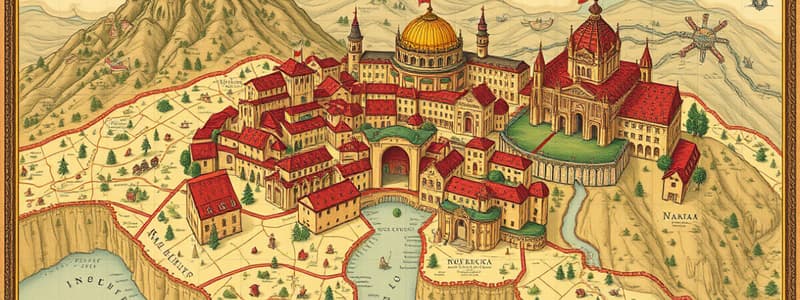Podcast
Questions and Answers
What type of map do choropleth, flowline, and graduated symbol represent?
What type of map do choropleth, flowline, and graduated symbol represent?
thematic
What kind of map represents point A to point B?
What kind of map represents point A to point B?
reference
Reference maps do not use data.
Reference maps do not use data.
True (A)
Reference maps represent a theme.
Reference maps represent a theme.
What is absolute distance expressed in?
What is absolute distance expressed in?
Relative distance is expressed in what terms?
Relative distance is expressed in what terms?
What does clustered refer to?
What does clustered refer to?
What does dispersed refer to?
What does dispersed refer to?
What does distortion refer to in terms of maps?
What does distortion refer to in terms of maps?
In the Mercator map, ___ appears larger than ___ even though the latter is way bigger than the former in real life.
In the Mercator map, ___ appears larger than ___ even though the latter is way bigger than the former in real life.
What is a small-scale map good for?
What is a small-scale map good for?
What is an interrupted map projection?
What is an interrupted map projection?
What becomes harder to read in an interrupted map projection?
What becomes harder to read in an interrupted map projection?
An interrupted map is not good for what?
An interrupted map is not good for what?
What is the advantage of an uninterrupted map projection?
What is the advantage of an uninterrupted map projection?
An uninterrupted map projection is better for __ and __.
An uninterrupted map projection is better for __ and __.
What is the biggest problem with maps?
What is the biggest problem with maps?
What shape does the Mercator map use?
What shape does the Mercator map use?
What is the Mercator map good at?
What is the Mercator map good at?
Why does the Mercator projection show size distortion?
Why does the Mercator projection show size distortion?
In the Mercator projection, developed countries appear larger while less developed countries appear smaller due to their location on the map.
In the Mercator projection, developed countries appear larger while less developed countries appear smaller due to their location on the map.
What does the Mercator map illustrate, conformal or equal area?
What does the Mercator map illustrate, conformal or equal area?
What type of projection is the Mercator?
What type of projection is the Mercator?
Is the Mercator map interrupted?
Is the Mercator map interrupted?
Who is associated with the Goode Homolosine projection?
Who is associated with the Goode Homolosine projection?
Is the Goode Homolosine projection interrupted?
Is the Goode Homolosine projection interrupted?
In the Goode Homolosine projection, landmasses are uninterrupted.
In the Goode Homolosine projection, landmasses are uninterrupted.
What does the Goode Homolosine projection minimize most distortion in?
What does the Goode Homolosine projection minimize most distortion in?
What does the Goode Homolosine projection struggle with?
What does the Goode Homolosine projection struggle with?
What category does the Goode Homolosine projection fall into?
What category does the Goode Homolosine projection fall into?
What does the Goode Homolosine projection illustrate, conformal or equal area?
What does the Goode Homolosine projection illustrate, conformal or equal area?
The Goode Homolosine is a ___ map, meaning multiple images are overlaid on top of one another to create one image.
The Goode Homolosine is a ___ map, meaning multiple images are overlaid on top of one another to create one image.
What is the Fuller projection good at?
What is the Fuller projection good at?
Why is the Fuller projection hard to interpret?
Why is the Fuller projection hard to interpret?
Is the Fuller projection interrupted?
Is the Fuller projection interrupted?
What does it mean that the Fuller projection is a compromised projection?
What does it mean that the Fuller projection is a compromised projection?
What is the general shape of the Robinson projection?
What is the general shape of the Robinson projection?
How does Robinson minimize distortion?
How does Robinson minimize distortion?
What four things all have distortion in the Robinson map?
What four things all have distortion in the Robinson map?
Is the Robinson projection interrupted?
Is the Robinson projection interrupted?
Flashcards are hidden until you start studying
Study Notes
Thematic and Reference Maps
- Thematic maps, like choropleth, flowline, and graduated symbol maps, emphasize specific themes or data.
- Reference maps are used for navigation from point A to point B and do not utilize data focused on specific themes.
Distance Concepts
- Absolute distance measures space quantitatively in kilometers or meters.
- Relative distance describes qualitative terms like time and direction, often indicated by a compass rose.
Spatial Arrangement
- Clustered refers to items packed closely together.
- Dispersed indicates significant space between items.
Map Distortion
- Distortion affects direction, distance, shape, and area; all maps compromise in some areas.
- Mercator projections exaggerate size, making Greenland appear larger than Africa despite Africa's actual size.
Map Types and Characteristics
- Small-scale maps generalize information and may not provide a complete picture.
- Interrupted map projections remove wedges of the map to minimize distortion but complicate ocean readability and navigation.
- Uninterrupted maps provide better accuracy for distance and direction but contain more distortion.
Mercator Projection
- The Mercator projection has a rectangular shape and excels at representing direction.
- It is conformal, maintaining angles while sacrificing size accuracy, especially at the poles.
- Developed regions appear larger, while less developed regions appear smaller due to their placement on the map.
Goode Homolosine Projection
- Named after John Hall Goode, this projection is interrupted and minimizes distortion for landmasses while maximizing size accuracy.
- It is pseudocylindrical and follows an equal-area format, useful for representing size correctly.
- Struggles with usability for direction, particularly in marine navigation.
Fuller Projection
- The Fuller projection accurately represents size and shape without interruptions but is difficult to interpret due to the absence of cardinal directions.
- It is an interrupted, compromised projection, aiming to spread distortion evenly across the map.
Robinson Projection
- The Robinson projection features a nearly rectangular shape with rounded corners and minimizes distortion through an even spread.
- All four map aspects - shape, size, distance, and direction - experience some level of distortion.
- It is an uninterrupted type of projection, balancing visual representation with navigational usability.
Studying That Suits You
Use AI to generate personalized quizzes and flashcards to suit your learning preferences.




